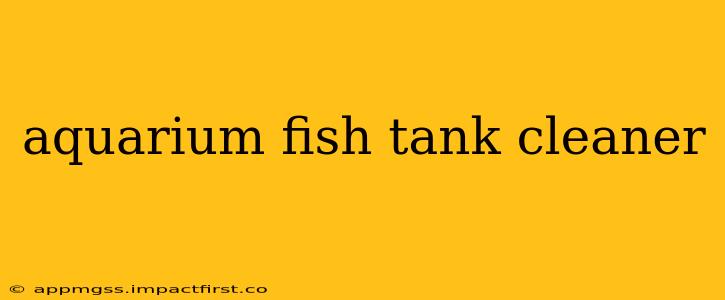Maintaining a pristine aquarium is crucial for the health and well-being of your fish. A clean tank prevents the buildup of harmful bacteria, algae, and waste, ensuring a thriving environment for your aquatic companions. But cleaning an aquarium isn't just about aesthetics; it's about responsible fishkeeping. This comprehensive guide will walk you through everything you need to know about cleaning your fish tank effectively and safely.
What are the different types of aquarium cleaners?
There's a surprising variety of aquarium cleaners available, each designed for a specific task. Understanding the differences is key to choosing the right tools for your tank. These include:
- Gravel Vacuums: These hand-held devices siphon water and debris from the substrate, removing waste and uneaten food. They're essential for maintaining water quality.
- Magnetic Algae Cleaners: These clever tools consist of two magnets, one inside and one outside the tank. The inner magnet scrubs algae from the glass while the outer magnet guides it. They're a fantastic way to keep glass sparkling clean without having to put your hands in the water.
- Algae Scrapers: For stubborn algae build-up, a good algae scraper is indispensable. Choose one with a sturdy blade but avoid anything too sharp to prevent scratching your tank's glass.
- Sponge Filters & Filter Media Cleaners: Regular cleaning of your filter media (e.g., sponge filters, bio-media) is crucial. While you should never completely sterilize your filter, gently rinsing the media in used aquarium water helps remove accumulated waste without harming beneficial bacteria.
- Water Change Kits: These kits make water changes easier and more efficient. They typically include a siphon hose for removing old water and a bucket for the new. Performing regular water changes is vital for maintaining healthy water parameters.
- Chemical Cleaners (use with caution!): While some chemical cleaners are marketed for aquariums, exercise extreme caution. Always thoroughly research the product and ensure it's specifically formulated for use in fish tanks and won't harm your aquatic life. Overuse of chemicals can disrupt the delicate ecosystem within your aquarium.
How often should I clean my fish tank?
The frequency of cleaning depends on several factors, including the tank size, the number of fish, and the type of filtration system you're using. However, here's a general guideline:
- Daily: Remove any uneaten food and visible debris from the tank's surface.
- Weekly: Partially change (around 25%) of the tank's water. This helps remove accumulated waste and replenish essential minerals.
- Monthly: Thoroughly clean the gravel vacuum. This is a critical step in removing waste that has settled into the substrate.
- Quarterly: Clean your filter media. Remember, rinse them in used aquarium water, not tap water, to preserve beneficial bacteria.
- As Needed: Clean algae as you notice it building up. Regular algae cleaning prevents excessive growth and maintains a pleasant aesthetic.
What are the best practices for cleaning a fish tank?
- Always use dechlorinated water: Tap water contains chlorine and chloramine, which are toxic to fish. Use a water conditioner to neutralize these chemicals before adding new water to your tank.
- Never use soap or detergents: These harsh chemicals can harm your fish and disrupt the delicate balance of your aquarium's ecosystem.
- Match the cleaner to the task: Don't try to use a gravel vacuum to clean algae; use the right tool for the job.
- Be gentle: Avoid jarring movements or harsh scrubbing that could damage your tank or frighten your fish.
- Test your water: Regularly test your water parameters (ammonia, nitrite, nitrate, pH) to monitor water quality and make adjustments as needed. This is crucial for preventing problems before they become serious.
How do I clean the filter in my aquarium?
Cleaning your aquarium filter is a crucial maintenance task. Never fully clean or sterilize the filter media, as it houses beneficial bacteria essential for biological filtration. Instead, follow these steps:
- Rinse the filter media in used aquarium water: This removes waste and debris without harming the beneficial bacteria.
- Avoid tap water: Tap water contains chlorine and chloramine, which can kill beneficial bacteria.
- Gently squeeze the filter media: Don't wring it out forcefully, as this can damage the filter media.
- Replace the filter media every 6-12 months: Over time, filter media loses its effectiveness and needs to be replaced.
Can I use vinegar to clean my fish tank?
While diluted white vinegar is sometimes suggested for removing algae, it's crucial to proceed with extreme caution. Vinegar can alter your tank's pH, potentially harming your fish and plants. It’s generally recommended to stick to aquarium-safe cleaning methods and products. Only use vinegar as a last resort, and even then only on small areas, after thoroughly researching its effects on your specific species and water parameters.
By following these guidelines and using the appropriate tools, you can keep your aquarium sparkling clean and provide a healthy, thriving habitat for your fish. Remember, regular maintenance is key to a successful and enjoyable aquarium experience.
